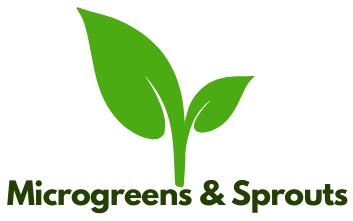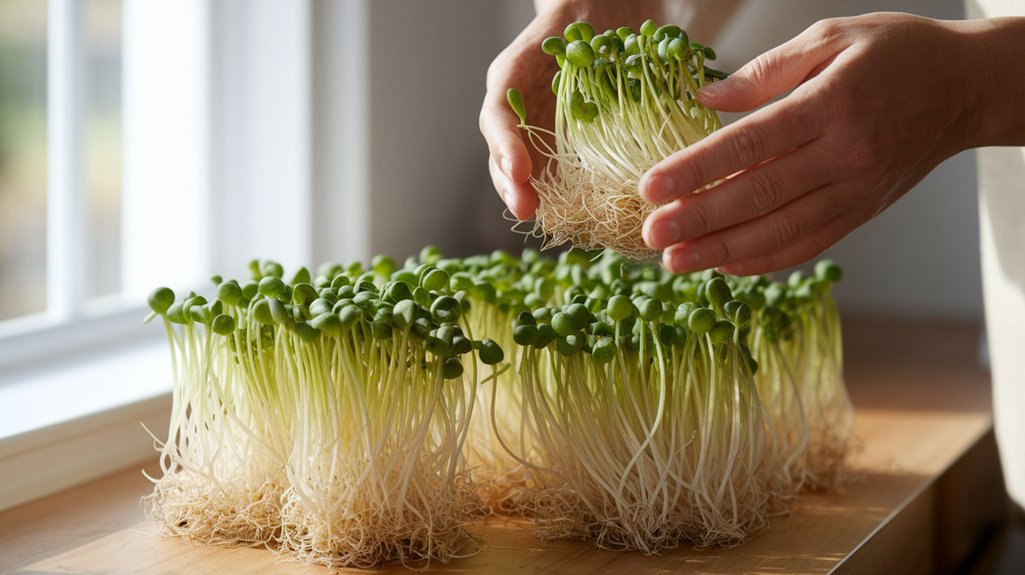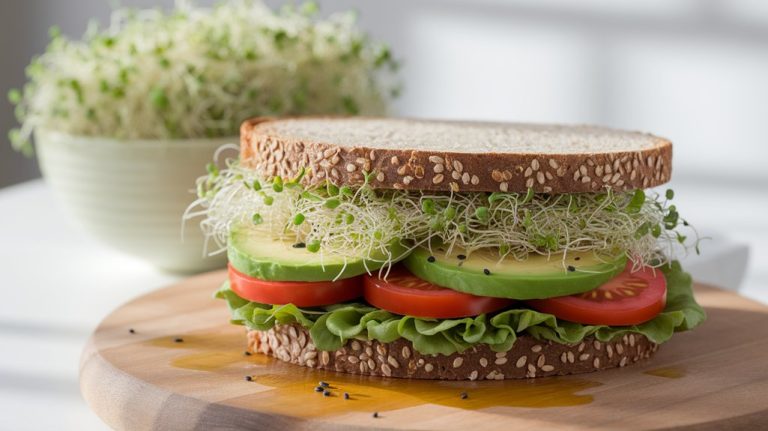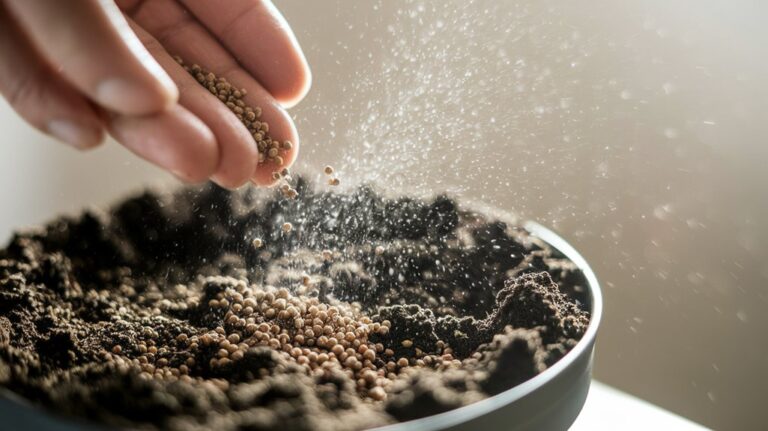How to Harvest Your Sprouts
To harvest my sprouts, I check for vibrant colors and crispness, which usually happens between days 5 to 14. Using clean scissors, I snip them just above the growing medium when they reach about 1 to 2 inches tall. After gathering, I rinse them under cool water to remove any debris and pat them dry with a towel. Proper post-harvest care keeps them fresh and tasty. There’s much more to explore about sprout storage and care!
Key Takeaways
- Check for vibrant color and firm texture before harvesting, typically between 5 to 14 days after germination.
- Use sharp kitchen scissors to snip sprouts above the growing medium for a clean cut.
- Gather harvested sprouts carefully to prevent bruising and damage during collection.
- Rinse sprouts under cool running water two to three times until the water runs clear to remove dirt.
- Store rinsed sprouts in breathable containers and monitor for wilting or discoloration.
Understanding the Growth Cycle of Sprouts

Understanding the growth cycle of sprouts is essential to ensure a successful harvest. I’ve found that sprouts typically go through several key phases: germination, growth, and maturation.
During germination, seeds soak up water and begin to sprout, usually within a day or two. I always keep an eye on moisture levels during this stage to encourage healthy growth.
Once they sprout, the growth phase kicks in, where tiny leaves emerge and the sprouts start to develop. This is when I make sure they get enough light but avoid direct sunlight to prevent scorching.
Finally, the maturation phase occurs, and that’s when the sprouts reach their peak size and flavor. It’s fascinating to witness this transformation right in my kitchen!
Determining the Right Time to Harvest
As you watch your sprouts grow, knowing when to harvest them becomes crucial for achieving the best flavor and texture.
Typically, I find the right time to harvest between days 5 to 14, depending on the type of sprout. For instance, alfalfa sprouts are usually ready in about 5 to 7 days, while broccoli sprouts take around 7 to 10 days.
I like to check for vibrant color and a firm texture. Once they reach about 1 to 2 inches in height, they’re generally perfect.
It’s essential to taste them, too—if they’re crunchy and flavorful, it’s time to harvest. Remember, the longer you wait, the more they can lose their freshness and taste.
Happy harvesting!
Tools You’ll Need for Harvesting
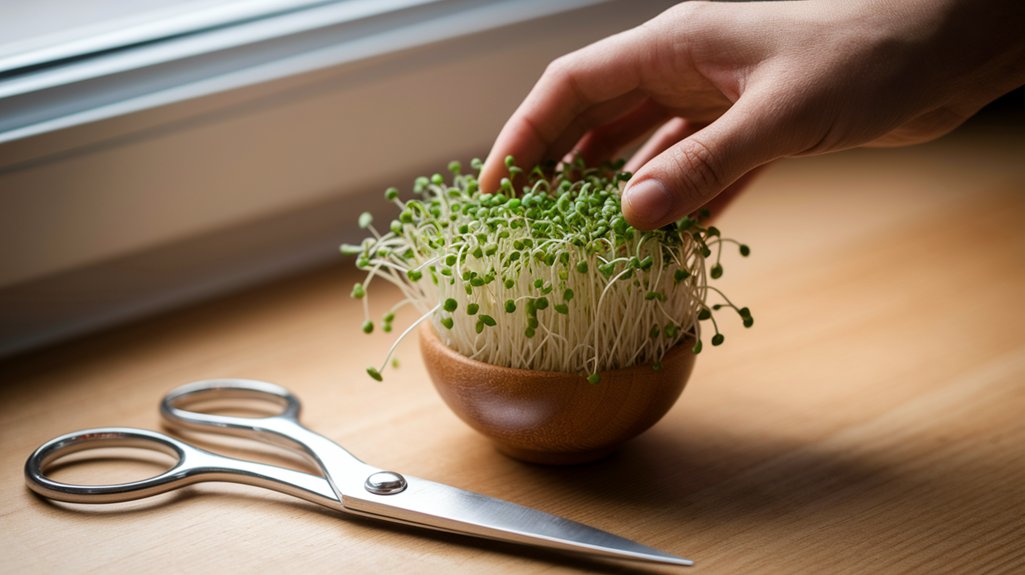
Harvesting your sprouts can be a rewarding experience, but having the right tools makes the process much smoother.
First, I recommend a sharp pair of kitchen scissors or shears. They’ll help you snip the sprouts cleanly without damaging them.
A clean bowl is also essential for collecting your freshly harvested sprouts—this keeps everything organized and makes it easier to rinse them afterward.
You might also want a fine mesh strainer for washing off any residual dirt or debris.
Lastly, having a clean, dry towel on hand is great for patting your sprouts dry.
With these tools, you’ll be well-prepared to enjoy the fruits of your labor! Happy harvesting!
Step-by-Step Harvesting Techniques
Get ready to enjoy the fruits of your labor by following these simple step-by-step harvesting techniques.
First, check your sprouts; they should be vibrant and crisp. Using clean scissors, gently snip the sprouts just above the growing medium, ensuring you don’t damage the roots. I prefer to harvest in the morning when they’re most hydrated.
Next, gather the sprouts in a bowl or basket, avoiding any bruising. If you’re harvesting multiple batches, label them to keep track of freshness.
Rinse your sprouts under cool running water to remove any debris. Finally, pat them dry with a clean towel.
You’re now ready to enjoy your homegrown sprouts in salads, sandwiches, or smoothies! Happy harvesting!
Post-Harvest Care and Cleaning
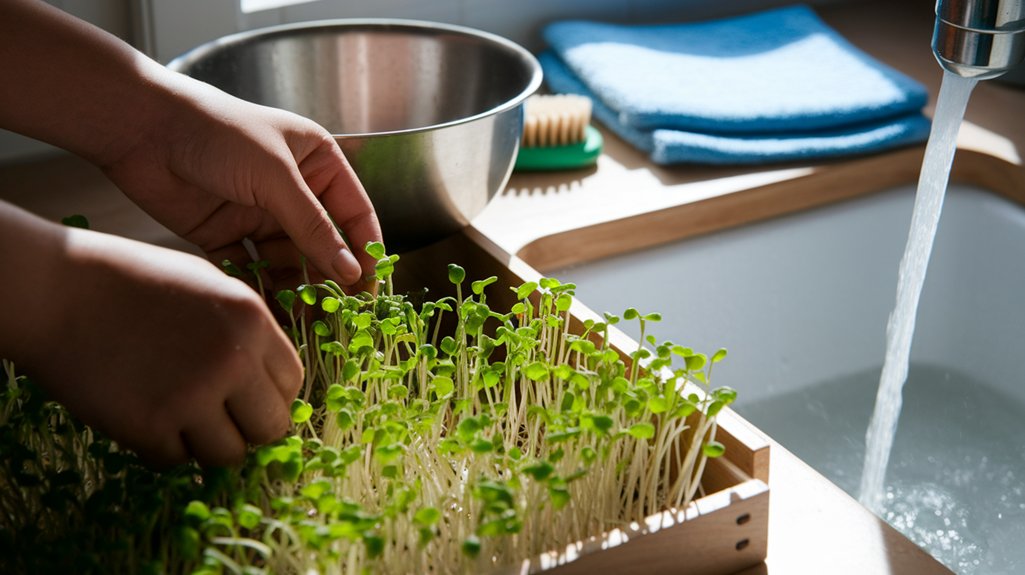
Once I’ve harvested my sprouts, the next step is all about keeping them fresh and clean.
I always rinse them thoroughly to remove any debris and enhance their crispness.
After that, I’ll share some handy storage tips to ensure they stay vibrant for as long as possible.
Rinsing Your Sprouts
Rinsing your sprouts is a crucial step in ensuring they’re clean and ready to enjoy. After harvesting, I take my sprouting jar or tray and hold it under cool running water. I gently swish the sprouts around with my hands to remove any residual debris or seed hulls.
It’s important to rinse them thoroughly, as this helps eliminate any bacteria that might’ve developed. I usually rinse my sprouts two to three times until the water runs clear. Once done, I let them drain well to avoid excess moisture.
This simple process not only enhances their freshness but also boosts their taste. Now, my sprouts are perfectly clean and ready to be added to salads, sandwiches, or enjoyed on their own!
Storage Tips Explained
After harvesting your sprouts, proper storage is essential to maintain their freshness and quality.
I usually rinse them thoroughly to remove any debris, then pat them dry with a clean towel.
Next, I place the sprouts in a breathable container, like a glass jar or a paper bag, to prevent moisture buildup.
It’s important not to pack them too tightly, as they need air circulation.
I store them in the fridge, where they’ll stay fresh for about a week.
If I notice any wilting or discoloration, I discard those sprouts to keep the rest healthy.
Following these steps helps ensure that my sprouts remain crisp and flavorful, ready for my next meal!
Storing Your Freshly Harvested Sprouts
Now that I’ve harvested my sprouts, it’s crucial to store them properly to maintain their freshness.
I want to share the ideal storage conditions, the best container choices, and tips on how long they’ll last.
Let’s ensure my delicious sprouts stay crisp and flavorful for as long as possible!
Ideal Storage Conditions
To keep your freshly harvested sprouts at their best, it’s essential to store them under the right conditions.
I find that the ideal temperature for sprouts is between 32°F and 41°F (0°C to 5°C). Keeping them in the fridge helps maintain their crispness and nutrient density.
It’s also crucial to ensure they’re dry before storage; excess moisture can lead to spoilage. I usually spread them out on a clean paper towel to absorb any remaining moisture.
Additionally, good airflow is vital, so I avoid tightly packing them.
Proper Container Choices
Choosing the right container for your freshly harvested sprouts is crucial, as it can significantly impact their freshness and longevity. I’ve found that using glass jars or breathable containers works best.
Glass jars keep moisture in without suffocating the sprouts, while breathable containers allow for air circulation, preventing mold growth. Make sure to avoid plastic bags, as they trap humidity and can lead to spoilage.
When storing, I always opt for containers that are clean and dry. If I’m storing larger batches, I divide them into smaller portions to minimize handling, keeping them fresher longer.
Lastly, label your containers with the date, so you know exactly when you harvested your sprouts. This way, you can enjoy their delicious crunch at its peak!
Shelf Life Tips
Once you’ve selected the right containers for your freshly harvested sprouts, storing them properly is key to maximizing their shelf life.
I usually place my sprouts in airtight containers to keep moisture at bay, which helps prevent spoilage. It’s essential to store them in the refrigerator, as the cool temperature significantly extends their freshness.
I also recommend layering a paper towel inside the container to absorb any excess moisture. Remember, sprouts are best enjoyed within a week, but they’ll often last longer if stored correctly.
Before using, I always give them a quick rinse and check for any signs of wilting or spoilage. Following these tips ensures I enjoy my sprouts at their peak flavor and nutrition!
Frequently Asked Questions
Conclusion
Harvesting your sprouts can be a rewarding experience, bringing fresh flavors and nutrients to your meals. By understanding their growth cycle and knowing when to pick them, you’ll ensure peak freshness. With the right tools and techniques, the process becomes simple and enjoyable. Don’t forget to care for and store your sprouts properly to maximize their shelf life. Now that you’re equipped with this knowledge, I can’t wait for you to enjoy the fruits of your labor!
